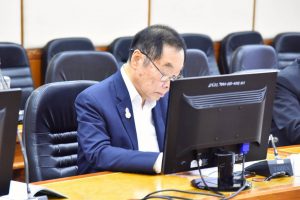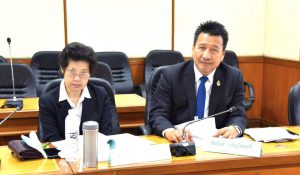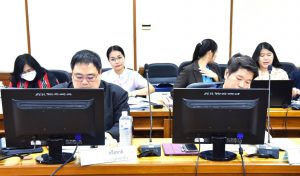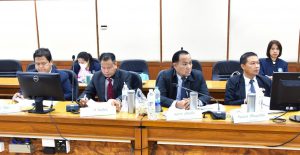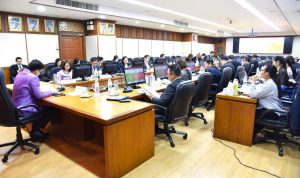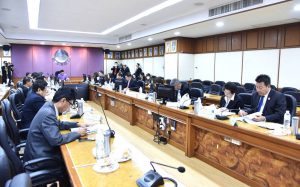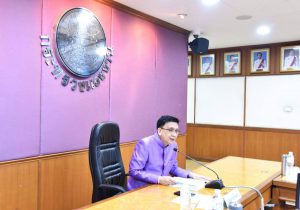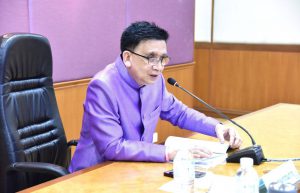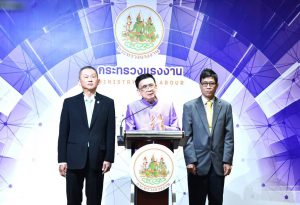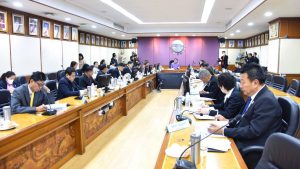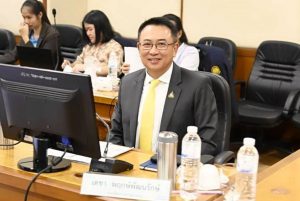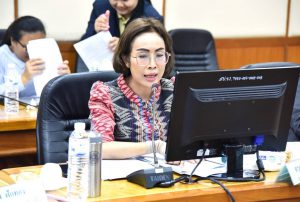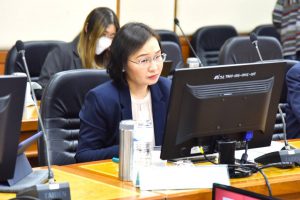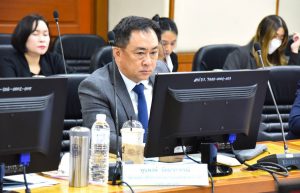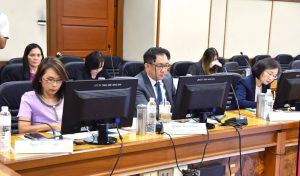วันที่ 27 กุมภาพันธ์ 2567 เวลา 13.30 น. นายไพโรจน์ โชติกเสถียร ปลัดกระทรวงแรงงาน แถลงภายหลังการประชุมคณะกรรรมการค่าจ้างชุดที่ 22 ครั้งที่ 2/2567 เพื่อพิจารณาสูตรการคำนวณอัตราค่าจ้างขั้นต่ำใหม่ และแนวทางการศึกษาความเป็นไปได้ในการกำหนดอัตราค่าจ้างขั้นต่ำว่า ในวันนี้คณะกรรมการค่าจ้างหรือบอร์ดไตรภาคีได้มีการประชุมเพื่อพิจารณาสูตรการคำนวณอัตราค่าจ้างขั้นต่ำใหม่และแนวทางการศึกษาความเป็นไปได้ในการกำหนดอัตราค่าจ้างขั้นต่ำที่คณะอนุกรรมการวิเคราะห์และปรับปรุงสูตรการคำนวณอัตราค่าจ้างขั้นต่ำเสนอ ซึ่งยังไม่ได้เป็นการสรุปว่าขึ้นค่าจ้างเท่าไหร่ โดยในการทบทวนและปรับปรุงสูตรการคำนวณอัตราค่าจ้างขั้นต่ำ คณะกรรมการค่าจ้างได้แต่งตั้งคณะอนุกรรมการวิเคราะห์และปรับปรุงสูตรการคำนวณอัตราค่าจ้างขั้นต่ำ เพื่อศึกษา วิเคราะห์ ทบทวน และปรับปรุงสูตรการคำนวณอัตราค่าจ้างขั้นต่ำให้มีความเหมาะสมยิ่งขึ้น
นายไพโรจน์ กล่าวต่อว่า การประชุมในวันนี้ ที่ประชุมได้เชิญผู้แทนคณะอนุกรรมการฯ มานำเสนอสูตรการคำนวณอัตราค่าจ้างขั้นต่ำใหม่แก่คณะกรรมการค่าจ้าง ซึ่งสูตรการคำนวณอัตราค่าจ้างขั้นต่ำใหม่ได้นำเรื่องมิติของเวลามาใช้ในการปรับค่าจ้าง ทำให้ยืดหยุ่นต่อการปรับระหว่างปี ทำให้ค่าจ้างที่ปรับใหม่เป็นค่าจ้างที่สะท้อนระยะเวลาการปรับค่าจ้างที่แท้จริงในปัจจุบันและเป็นธรรมกับแรงงาน เช่น มีการปรับอัตราค่าจ้างครั้งหลังสุดในเดือนตุลาคม 2565 และมีการปรับอัตราค่าจ้างครั้งใหม่ในเดือนมกราคม 2567 คิดเป็นจำนวนเดือนที่ไม่มีการปรับอัตราค่าจ้างขั้นต่ำเท่ากับ 15 เดือน นอกจากนี้มาตรา 87 ที่ใช้ในการพิจารณาประกอบเพิ่มเติมจากสูตรการคำนวณได้มีการปรับช่วงของการพิจารณาให้สอดคล้องเหมาะสมกับสถานการณ์ในปัจจุบัน ส่วนตัวแปรอื่น ๆ ได้แก่ ผลิตภาพแรงงาน อัตราเงินเฟ้อ อัตราสมทบของแรงงาน (ค่า L) ยังคงเหมือนสูตรเดิม
“จากการพิจารณาข้อมูลที่คณะอนุกรรมการฯ เสนอ คณะกรรมการค่าจ้างจึงมีมติเห็นชอบสูตรการคำนวณอัตราค่าจ้างขั้นต่ำใหม่ตามที่คณะอนุกรรมการฯ เสนอ และเห็นชอบแนวทางการศึกษาความเป็นไปได้ในการกำหนดอัตราค่าจ้างขั้นต่ำตามพื้นที่ โดยให้มีการสำรวจข้อมูลประเภทกิจการด้านท่องเที่ยวและบริการในพื้นที่ที่มีรายได้จากการท่องเที่ยวสูง 10 จังหวัด ได้แก่ กรุงเทพมหานคร ภูเก็ต ชลบุรี เชียงใหม่ สุราษฎร์ธานี กระบี่ สงขลา พังงา ประจวบคีรีขันธ์ และระยอง เพื่อสำรวจข้อเท็จจริงเกี่ยวกับอัตราค่าจ้างที่ลูกจ้างได้รับอยู่ มาตรฐานการครองชีพ ค่าใช้จ่ายที่จำเป็นของลูกจ้าง และข้อเท็จจริงทางสังคมและเศรษฐกิจตามพื้นที่ต่าง ๆ ตลอดจนความสามารถในการจ่ายของนายจ้างและกลุ่มผู้ประกอบการ SMEs เพื่อนำมาวิเคราะห์และประมวลผลประกอบการพิจารณาของคณะกรรมการค่าจ้างต่อไป
ทั้งนี้ เราจะประชุมคณะกรรรมการค่าจ้างไตรภาคีอีกครั้งในวันที่ 26 มีนาคม 2567 และหลังจากนี้ไปจะเป็นการสำรวจซึ่งจะทำให้สามารถทราบสูตรการคำนวณการขึ้นอัตราค่าจ้างเป็นรายพื้นที่ให้เหมาะสม” นายไพโรจน์ กล่าว
On February 27, 2024, at 13.30 hours, the Permanent Secretary of Labour, Mr. Phairoj Chotikasathien, gave a statement after the meeting of the 22nd Wage Committee, No. 2/2024, to consider the formula for calculating the new minimum wage rate and guidelines for studying the feasibility of determining the minimum wage rate. Today, the Wage Committee or Tripartite Board held a meeting to consider the formula for calculating the new minimum wage rate and the guidelines for studying the feasibility of determining the minimum wage rate to be analyzed and improved by the subcommittee on the formula for calculating the proposed minimum wage rate. The amount of the wage increase has not yet been summarized. In reviewing and improving the formula for calculating the minimum wage rate, the Wage Committee has appointed a subcommittee to analyze and improve the minimum wage rate calculation formula to study, analyze, review, and improve it to be more appropriate.
Mr. Phairoj continued that the meeting today invited representatives of the subcommittee to present the formula for calculating the new minimum wage rate to the Wage Committee. The formula for calculating the new minimum wage takes the time dimension into account when adjusting wages. This makes it flexible for adjustments during the year, making the new wage adjustment a wage that reflects the current actual wage adjustment period and is fair to workers. For example, the last wage rate adjustment was in October 2022, and there will be a new wage rate adjustment in January 2024. The formula considers the number of months in which the minimum wage rate has not been adjusted, which is 15 months. In addition, Section 87, which is used in consideration in addition to the calculation formula, has adjusted the range of consideration to be consistent with the current situation. Other variables include labour productivity and inflation rates, and the labour contribution rate (L value) remains the same as the original formula.
“From considering the information by the subcommittee, the Wage Committee has resolved to approve the formula for calculating the new minimum wage rate as proposed by the subcommittee and approved the guidelines for studying the feasibility of determining the minimum wage rate according to area. There will be a survey of data on the types of tourism and service businesses in areas with high tourism income in 10 provinces, namely Bangkok, Phuket, Chonburi, Chiang Mai, Surat Thani, Krabi, Songkhla, Phang Nga, Prachuap Khiri Khan and Rayong, in order to explore facts about the wages that employees receive, the standard of living, necessary expenses of employees and social and economic data in various areas. It also explores employers’ ability to pay, including SMEs, which will be analyzed and processed for consideration by the Wage Committee.”.
“We will meet the Tripartite Wage Committee again on March 26, 2024, and after this, there will be a survey that will allow us to understand the appropriate formula for calculating wage increases for each area,” said Mr. Phairoj.



